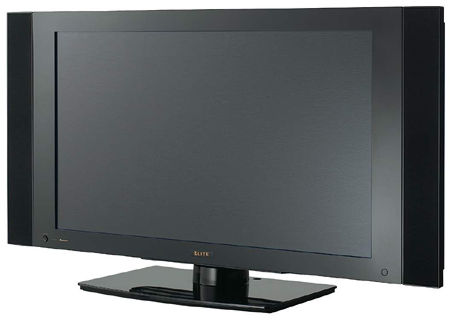Pioneer Elite PRO-1120HD Plasma Display System

Last year, Pioneer's flagship plasma package was the Elite PRO-1110HD. The PRO-R04U Media Receiver included in that package had an HDTV tuner but lacked CableCARD facilities. The new system corrects that shortcoming. It offers an ATSC tuner for receiving terrestrial DTV, an NTSC tuner for standard-definition analog broadcasts via antenna or analog cable feed, and onboard CableCARD functionality for receiving premium digital cable programming, including HDTV, without the need for a separate cable box. We did not test the CableCARD feature since its functionality depends more on the card provided by your cable provider than the reader in the PR0-R05U. (To learn more about CableCARDs, see Pete Putman's feature.)
As a bonus, the PRO-1120HD costs less than last year's model. We've also seen it for considerably less than its relatively high list price, thanks to fierce competition in the flat-panel business and Pioneer's acquisition last year of NEC's substantial plasma-production facilities.
Walkabout
The PRO-R05U houses all of the system's inputs and outputs, apart from speaker outputs on the PRO-1120HD and the two links between the receiver and display (one for control, the other for picture). Apart from the RF connections for its cable and over-the-air reception capabilities, there are four separate video inputs, a VGA input, and two iLink (IEEE1394) jacks, which are designed to be used with HD recording devices such as D-VHS tape decks. Several of the connectors (which include two HDMI) are shared under each numbered input (see Specifications), so there aren't quite as many completely independent inputs as it first appears. But most users will likely find the input selection more than adequate. The video controls can also be individually adjusted for each numbered input.
There are a few basic controls on the plasma panel, but none on the media receiver, so don't loose the remote. Speaking of which, the remote is illuminated, though the labels for some of the buttons, including those you might want to use in the dark, are not visible even with the backlighting. On the plus side, there are direct-access buttons for the inputs, and the remote can control four different devices (TV, cable/satellite, VCR, and DVD/DVR), either by entering the appropriate codes into its memory or making use of its learning capability.
Onscreen menus provide full control over setup, video, and audio. There are five color-temperature presets, plus a user-accessible manual color-temperature setting with full calibration controls. There are also two noise-reduction controls: DNR (Digital Noise Reduction), and MPEG NR for MPEG mosquito noise. Something called CTI (Color Transient Improvement) is said to provide "clearer color contours." There is also a DRE (Dynamic Range Enhancement) adjustment with four settings (Off, High, Mid, Low) and a Color Management control allowing individual control of red, yellow, green, cyan, blue, and magenta. Except as noted below, I left most of these controls in their off or neutral positions.
Pioneer designed the Elite PRO-1120HD with ISF (Imaging Science Foundation) calibration aids—called ISF C3 (Custom Calibration Configuration)—including setup via RS-232 and a special locked memory for an ISF calibrator to save his or her settings. The ISF software is compatible with a variety of calibration tools, and the ISF C3 feature remains hidden to the viewer or calibrator until one of those tools is employed. (There is no mention whatsoever of this ISF feature in the owner's manual.) But to use it, you need special software (from Milori) to complement your calibration device. Since we lacked that software, we relied solely on our Photo Research PR-650 SpectraColorimeter to perform the calibration the old-fashioned way, and employed the standard User memory to save the results.
As expected, Pioneer's PureCinema deinterlacing detects film-based sources. It can be turned off, set to Standard (STD) to enable 3:2 pulldown for use with interlaced film-originated sources, or switched to ADV (Advanced), which is a 3:3 pulldown mode. That is, it takes film-based material that was produced at 24 frames per second and displays it at 72fps on the screen. In theory this should produce smoother motion than conventional 3:2 pulldown.
The usual slate of selectable aspect ratios are available, including one of those uneven stretchy modes designed to turn 4:3 into some semblance of a full widescreen experience. There is also a mode that adjusts the side bars in 4:3 material to correspond to the brightness of the image and minimize the chance of burn-in.
The display has a built-in, low-powered stereo amplifier for use with outboard speakers, and removable, cosmetically matching speakers are provided with the system. You may use them or leave them in the box they came in, as I did. If you have room for them, they might be useful for casual TV watching, but they are no substitute for a good home theater surround system.
The PRO-R05U Media Receiver emitted a low-level mechanical hum, which was only just audible from a reasonable distance in a quiet room. It shouldn't be a concern with audio playing at any normal level.

The PRO-1120HD package includes Pioneer's next-generation plasma panel. The company's ACE III (Advanced Continuous Emission III) technology uses 10-bit video processing. While consumer video sources are limited to 8 bits, there are technical advantages to processing them at a higher bit depth.
- Log in or register to post comments




















































